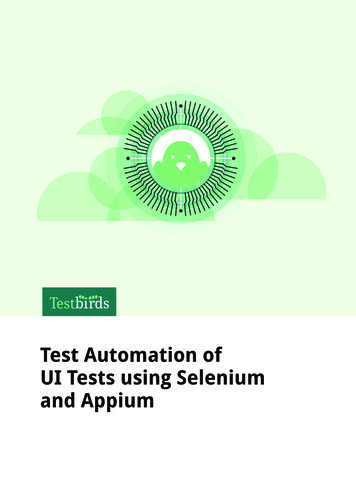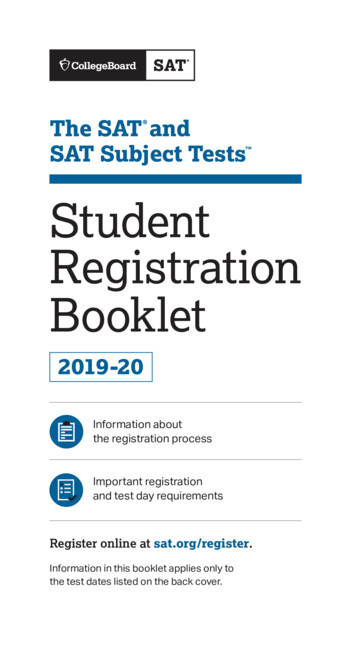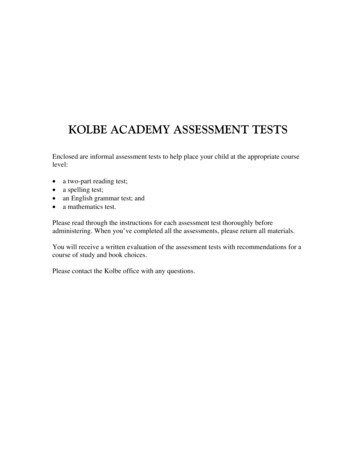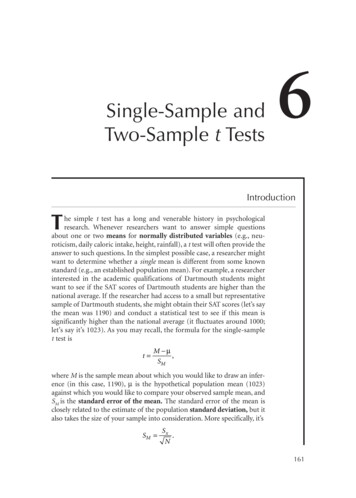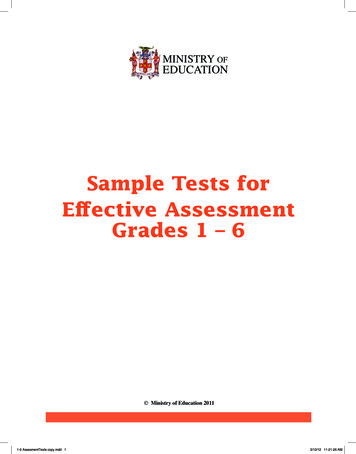
Transcription
Recommended performance-based teststo assess physical function in peoplediagnosed with hip or knee osteoarthritisRecommended SetMinimumCore Set30s Chair Stand Test40m Fast-paced Walk TestStair Climb TestTimed up & Go Test6 Minute Walk TestOARSI Funded InitiativeCentre for Health Exercise and Sports MedicineDepartment of Physiotherapy1University of Melbourne, Australia
Contributors and AcknowledgmentsAuthors:Fiona Dobson1, Kim L. Bennell1 Rana S. Hinman1, J Haxby Abbott2, Ewa M. Roos1,3Affiliations:1Centre for Health, Exercise and Sports Medicine, Department of Physiotherapy, School of HealthSciences, University of Melbourne, Australia2Centre for Musculoskeletal Outcomes Research, Dunedin School of Medicine, University of Otago,New Zealand3Institute of Sports Science and Clinical Biomechanics, University of Southern Denmark, DenmarkCorresponding author: Fiona Dobson. 200 Berkeley Street, Victoria, 3010, ering Committee:Kim Bennell, The University of Melbourne, AustraliaRana Hinman, The University of Melbourne, AustraliaJ Haxby Abbott, University of Otago, New ZealandEwa Roos, The University of Southern Denmark, DenmarkAdvisory Group:Paul Stratford, McMaster University, CanadaAileen Davis, Toronto Western Research Institute/University of Toronto, CanadaLynn Snyder-Mackler, University of Delaware, USARachelle Buchbinder, Monash University, AustraliaYves Henrotin, Institute of Pathology Liège, BelgiumJulian Thumboo, Singapore General Hospital, SingaporeThis project was partly funded by the Osteoarthritis Research Society International (OARSI), NHMRCProgram Grant #631717, the Arthritis Australia and States & Territory Affiliates Grant 2012 andUniversity of Otago DSM Dean's Bequest Grant. It forms part of an OARSI initiative to develop arecommended set of physical performance measures for hip and knee osteoarthritis. Kim Bennell ispartly funded by an Australian Research Council Future Fellowship. The study sponsor did not playany role in the study design, collection, analysis or interpretation of data; nor in the writing of themanuscript or decision to submit the manuscript for publication.2
Table of ContentsBackground and Process. 4User Statement: . 4Background: . 4Consensus process: . 5Phases of project . 5Selected tests . 530-second Chair Stand Test . 7Stair Climb Test . 940m (4x10m) Fast Paced Walk Test . 11Timed Up and Go Test . 13Six Minute Walk Test . 15Appendix 1: Clinimetrics in OA . 17Appendix 2 - Score sheets and normal values. 213
Background and ProcessUser Statement:This OARSI recommended set of performance-based tests of physical function are best suited forolder individuals ( 40 years) diagnosed with hip and/or knee osteoarthritis (OA), including endstage disease or following joint replacement. They are intended for use by both clinicians andresearchers as performance outcome measures and are viewed as complementary to establishedself-report measures such as questionnaires.Although the tests in the recommended set were selected based on global expert opinion andavailable clinimetric evidence, none of the tests fulfil all desirable criteria, limiting the ability for adefinitive core set of tests to be defined. Some tests described in the recommended set requirefurther clinimetric evidence for people with OA, some require modifications to scoring procedures toenable more meaningful score interpretations and others require procedural modifications tostandardize them across different clinical and research sites. Therefore this set of recommendedtests represents what are considered the current best available tests as of January 2013.Background:A Steering Committee was established in 2011 to identify the best performance-based tests ofphysical function. With input from OARSI, an international, multidisciplinary Advisory Group (clinicaland/or methods experts) was selected to provide a broad international representation; to representboth clinical and research expertise across the disease stages; and to encompass differentdisciplinary backgrounds. Members were also selected based on their international standing in OApractice and/or research and/or expertise in outcome measurement.Steering committee members:Kim Bennell, The University of Melbourne, AustraliaRana Hinman, The University of Melbourne, AustraliaEwa Roos, The University of Southern Denmark, DenmarkAdvisory group members:Paul Stratford, McMaster University, CanadaAileen Davis, Toronto Western Research Institute/University of Toronto, CanadaHaxby Abbott, University of Otago, New ZealandLynn Snyder-Mackler, University of Delaware, USARachelle Buchbinder, Monash University, AustraliaYves Henrotin, Institute of Pathology Liège, BelgiumJulian Thumboo, Singapore General Hospital, SingaporeProject Coordinator:Fiona Dobson, The University of Melbourne, Australia4
Consensus process:A consensus-based, decision analysis approach was used to select the performance-based measuresof physical function. This was achieved using a series of online decision surveys using the 1000Mindsprogram, a multi-attribute decision analysis research tool developed at the University of Otago, NZ(1). An advantage of using 1000Minds over alternate consensus processes is that it is cognitively lesschallenging as it requires decisions on a series of pairs (alternate scenarios) rather than rankingnumerous alternatives as the one time. Use of 1000Minds can also help guard against the “loudestvoice” in a focus group situation. The program is user-friendly as long as participants have access tothe internet. Analysis of participant’s choices occurs in the background and group results areprocessed automatically and quickly regardless of how many participants are included in the task.1000Minds has previously been used by the American College of Rheumatology/European LeagueAgainst Rheumatology for expert consensus on the classification of rheumatoid arthritis (2).Phases of projectFollowing consultation with the Advisory Group, the consensus process consisted of five progressivephases:(1) Identification of candidate tests from review of the literature including a systematic reviewof the measurement properties of performance-based tests in older people with establishedhip and knee OA (3).(2) An international expert consensus using 1000Minds to rank the difficulty of functional testsin people diagnosed OA to identify which tests were most applicable across the spectrum offunctioning and more applicable to people with established OA.(3) A large global consensus of both clinicians and researchers using 1000Minds survey to rankthe feasibility (practical issues such as time required, cost, equipment, space, administrationburden) of tests.(4) A consensus of the advisory group using 1000Minds to identify the preferred performancebased tests based on feasibility, the available measurement property evidence identified inthe systematic review and the scoring methods used.(5) A meeting by the advisory group to select the Recommended Set (5 tests) and the MinimalCore Set (3 tests) (see below).Selected testsThe selected tests for the Recommended Set for people diagnosed with hip and knee OA are:Recommended set of performance-based measuresof physical functionRecommended ActivityRecommended TestMinimum core setSit-to-stand30 second chair stand testWalking short distances4x10m fast-paced walk testStair negotiation[No test recommendation]Ambulatory transitionsTimed up and go testAerobic capacity / walking longSix-minute walk testdistances5
Suggested guidelines for the use of the Timed Up and Go Test and Six Minute Walk Test are: To compare across different population groups To continue existing databases/research protocols /standard clinical testing In studies focusing on physical function as the main outcome dimensionAdditional suggested guidelines for the use of the Six Minute Walk Test are: To compare function across the life spans (i.e. younger and older individuals with OA) When the interaction of co-morbidities on walking ability is the desired outcome (forexample weight loss study)REFERENCES1.Hansen P, Ombler F. A new method for scoring additive multi-attribute value models using pairwiserankings of alternatives. Journal of Multi-Criteria Decision Analysis. 2008;15(3-4):87-107.2.Neogi T, Aletaha D, Silman AJ, Naden RL, Felson DT, Aggarwal R, et al. The 2010 American College ofRheumatology/European League Against Rheumatism classification criteria for rheumatoid arthritis: Phase 2methodological report. Arthritis Rheum. 2010;62(9):2582-91.3.Dobson F, Hinman RS, Hall M, Terwee CB, Roos EM, Bennell KL. Measurement properties ofperformance-based measures to assess physical function in hip and knee osteoarthritis: A systematic reviewOsteoarthritis and Cartilage 2012;doi: 10.1016/j.joca.2012.08.015.6
30-second Chair Stand TestAbbreviation: 30s-CSTPurpose / DomainsA test of sit-to-stand activity.Also a test of lower body strength and dynamic balance.Repeat for 30 secondsICF code (1): d410 Changing basic body position.DescriptionThe maximum number of chair stand repetitions possible in a 30 second period (2-4).Equipment Timer/stop watch.Straight back chair with a 44cm (17 inch) seat height, preferably without arms.Same chair should be used for re-testing within sites.PreparationEnvironment Ensure the chair cannot slide backwards by placing the back of the chair against a wall.Participant Comfortable walking footwear (e.g. tennis shoes/cross trainers) should be worn. The participant sits in the chair in a position that allows them to place their feet flat on thefloor, shoulder width apart, with knees flexed slightly more than 90 degrees so that theirheels are somewhat closer to the chair than the back of their knees. The arms are crossed at the wrists and held close to the chest (across chest).Tester The tester stands close to the side of the chair for safety and so as they can observe thetechnique, ensure that the participant comes to a full stand and full sit position during thetest.Practice A practice trial of one or two slow paced repetitions is recommended before testing to checktechnique and understanding.Procedure From the sitting position, the participant stands up completely up so hips and knees are fullyextended, then completely back down, so that the bottom fully touches the seat. This isrepeated for 30 seconds.Same chair should be used for re-testing within site.If the person cannot stand even once then allow the hands to be placed on their legs or usetheir regular mobility aid. This is then scored as an adapted test score.7
Verbal instructions“For this test, do the best you can by going as fast as you can but don’t push yourself to a pointof overexertion or beyond what you think is safe for you.1. Place your hands on the opposite shoulder so that your arms are crossed at the wrists andheld close across your chest. Keep your arms in this position for the test.2. Keep your feet flat on the floor and at shoulder width apart.3. On the signal to begin, stand up to a full stand position and then sit back down again so asyour bottom fully touches the seat.4. Keep going for 30 seconds and until I say stop.5. Get ready and START”.Scoring On the signal to begin, start the stop watch. Count the total number of chair stands (up anddown equals one stand) completed in 30 seconds. If a full stand has been completed at 30seconds (i.e. standing fully erect or on the way down to the sitting position), then this finalstand is counted in the total. The participant can stop and rest if they become tired. The time keeps going. If a person cannot stand even once then the score for the test is zero. Next, allow the hands to be placed on their legs or use their regular mobility aid. If theperson can stand with adaptions, then record the number of stands as an adapted test score(see score sheet). Indicate the adaptations made to the test.Minimal reporting standards Chair height.Adaptations – such as using hands on legs or using a walking aid.N.B. The individual should use the assistive device (if any) they would normally use to performthe activity at the time of testing, irrespective of how they performed it previously. However, ifan assistive device/rail is used, then it should be recorded for that occasion.REFERENCES1.World Health Organization. International Classification of Functioning, Disability, and Health: ICF.Geneva, Switzerland 2001.2.Gill S, McBurney H. Reliability of performance-based measures in people awaiting joint replacementsurgery of the hip or knee. Physiother Res Int. 2008;13(3):141-52.3.Jones CJ, Rikli RE, Beam WC. A 30-s chair-stand test as a measure of lower body strength incommunity-residing older adults. Res Q Exerc Sport. 1999;70(2):113-9.4.Kreibich DN, Vaz M, Bourne RB, Rorabeck CH, Kim P, Hardie R, et al. What is the best way of assessingoutcome after total knee replacement? Clin Orthop Relat Res. 1996(331):221-5. Epub 1996/10/01.8
Stair Climb TestAbbreviation: x-step SCT (where x is the number of steps e.g. 9-step SCT)Purpose / DomainsA test of ascending and descending stair activity.Also a test of lower body strength and balance.ICF codes (1): d410 Changing basic body position, d455 Moving around, d4551 Climbing.DescriptionThe time (in seconds) it takes to ascend and descend a flight of stairs (2-6).The number of stairs will depend on individual environmental situations.Where possible, the 9-step stair test with 20cm (8 inch) step height and handrail is recommended.Equipment Timer/stop watch.Flight of stairs.PreparationEnvironment Suitable step heights (between 16-20cm). Ensure adequate lighting and free from traffic and external distractions.Participant Comfortable walking footwear (e.g. tennis shoes/cross trainers) should be worn.Tester If safety is of concern, the tester should guard behind/below the participant going up thestairs and ahead/to the side coming down the stairs. If there is no concern for safety, the tester should remain at the start/finish position on theground landing.Practice A practice trial with tester guarding is recommended before testing to assess for safety.Procedure Ascend and descend flight of stairs as quickly as possible but in a safe manner.Use of a handrail and walking aid is permitted if needed. Use should be recorded.Same stairs should be used for re-testing within site.9
Verbal instructions“For this test, do the best you can by going as fast as you can but don’t push yourself to a pointof overexertion or beyond what you think is safe for you.1. Start with both feet on the bottom landing.2. On start, go to the top of the stairs as fast but as safe as you can, turn around and returnback down and stop with both feet back on the ground landing.3. Use the rail only if needed.4. Get ready and START”.Scoring Timing begins on the signal to start and terminates when the participant returns with bothfeet to the ground level. Total time to ascend and descend steps for 1 test trial is recorded to nearest 100th of asecond. The participant can stop and rest if needed but the time keeps going.Minimal reporting standards Number of stairs in flight and step height (rise).Use of hand rail (for ascent / descent / both) and side of hand rail.Use of walking aids.N.B. The individual should use the assistive device (if any) they would normally use to performthe activity at the time of testing, irrespective of how they performed it previously. However, ifan assistive device/rail is used, then it should be recorded for that occasion.REFERENCES1.World Health Organization. International Classification of Functioning, Disability, and Health: ICF.Geneva, Switzerland 2001.2.Davey RC, Edwards SM, Cochrane T. Test-retest reliability of lower extremity functional and selfreported measures in elderly with osteoarthritis. Advances in Physiotherapy. 2003;5(4):155-60.3.Kennedy DM, Stratford PW, Wessel J, Gollish JD, Penney D. Assessing stability and change of fourperformance measures: a longitudinal study evaluating outcome following total hip and knee arthroplasty.BMC Musculoskelet Disord. 2005;6:3.4.Mizner RL, Petterson SC, Clements KE, Zeni Jr JA, Irrgang JJ, Snyder-Mackler L. Measuring FunctionalImprovement After Total Knee Arthroplasty Requires Both Performance-Based and Patient-ReportAssessments. A Longitudinal Analysis of Outcomes. J Arthroplasty. 2011;26(5):728-37.5.Stratford PW, Kennedy DM, Riddle DL. New study design evaluated the validity of measures to assesschange after hip or knee arthroplasty. J Clin Epidemiol. 2009;62(3):347-52.6.Stratford PW, Kennedy DM, Woodhouse LJ. Performance measures provide assessments of pain andfunction in people with advanced osteoarthritis of the hip or knee. Phys Ther. 2006;86(11):1489-96.10
40m (4x10m) Fast Paced Walk TestAbbreviation: 40m FPWTPurpose / DomainsA test of short distance walking activity.A test of walking speed over short distances and changing direction during walking.ICF codes (1): d410 Changing basic body position, d450 Walking, d455 Moving around.DescriptionA fast-paced walking test that is timed over 4 x 10m (33 ft) for a total 40 m (132 ft) (2).Guidelines for use As a direct measure of the ability to walk quickly over short distances, which is an activitythat is important but often limited in people with hip and/or knee OA.Equipment Timer/stop watch.10 m (33 ft) marked walkway with space to turn safely around at each end.2 cones place approximately 2 metres beyond each end of the 10m walkway.Calculator to convert time to speed.PreparationEnvironment Mark out a 10 m (33 ft) walkway with bright coloured tape at each end. Place a cone approximately 2 metres before the start mark and 2 meters beyond the finishmark of the 10m walkway for turning. Ensure there is enough space to turn safely around at each end (i.e. 2-3m each end).Participant Comfortable walking footwear (e.g. tennis shoes/cross trainers) should be worn.Tester If safety is of concern, the tester should follow slightly behind and off to one side to theparticipant but not as to pace or impede them. If there is no concern for safety, the tester should follow well to the side so as they can viewcrossing at the 10m walkway at both ends.Practice A practice trial of 1-2 turns is recommended before testing to check understanding.Procedure
2 Contributors and Acknowledgments Authors: Fiona Dobson 1, Kim L. Bennell 1,3Rana S. Hinman , J Haxby Abbott2, Ewa M. Roos Affiliations: 1Centre for Health, Exercise and Sports Medicine, Department of Physiotherapy, School of Health Sciences, University of Melbourne, Australia 2Centre for Musculoskeletal Outcomes Research, Dunedin School of Medicine, University of Otago,
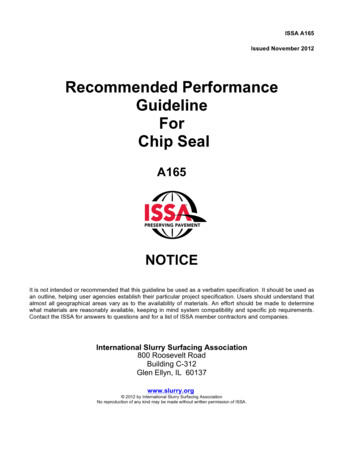
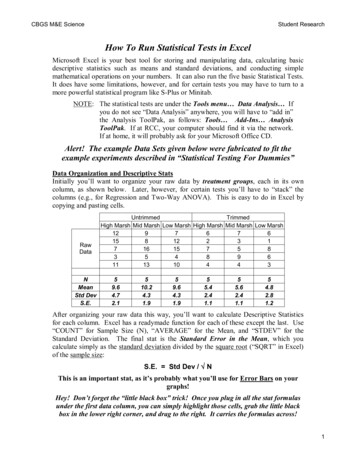
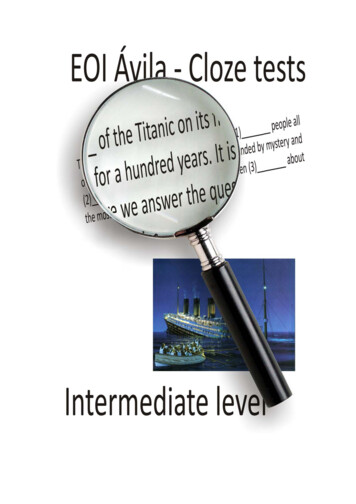
![Hardness Tests [3]](/img/2/lmcm2-aula3.jpg)
